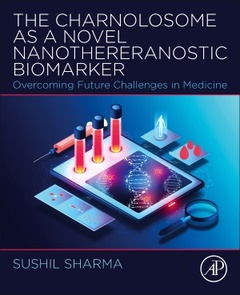- Overcoming Future Challenges in Medicine
Auteur : Sharma Sushil

The Charnolosome as a Novel Nanothereranostic Biomarker: Overcoming Future Challenges in Medicine provides an overview of the charnolosome and its potential as a biomarker of cell injury. Based on the author’s original discovery of the charnoly body in the developing, undernourished rat cerebellar Purkinje neurons, this book delves into the potential for utilizing this mitochondria and lysosomal-derived intracellular organelle as a nanotheranostic biomarker to prevent and cure various diseases. The book discusses the cellular, molecular, genetic, and epigenetic mechanisms of charnolosomes and charnolosome-derived nano-vesicles. It also investigates the molecular mechanisms underlying auto-inflammatory, autoimmune, and infectious diseases resulting from their compromised mitochondrial bioenergetics, and the potential use of the charnolosome in preventing and curing such conditions.
Section I: General Topics 1. Transcriptional regulation of Charnolosome through gene/base-editing 2. Charnolosome destabilization induces inflammasome activation 3. Charnolosome in Charnoly Body molecular pathogenesis of gene-manipulated cells and animals 4. Charnolosome and inflammasome in chronic MDR diseases 5. Charnolosome stabilization inhibits inflammasome to confer personalized nanotheranostic benefit in chronic MDR diseases 6. Endogenous, natural, and synthetic antioxidants stabilize charnolosome and its exocytosis to confer theranostic benefit by inflammasome inhibition 7. Charnolosome stability index (stabilized Charnolosome vs activated inflammasome) determines normal cellular function to remain healthy 8. Charnolosome stability index regulates Charnoly Body molecular pathogenesis 9. Nanotheranostic significance of antioxidants in Charnolosome detoxification 10. Theranostic significance of Charnolosome in personalized nanomedicine 11. Environmental toxins and transcriptional regulation of Charnolosome 12. Antioxidants-mediated Charnolosome transcriptional regulation in health and disease 13. Mitochondrial bioenergetics, Charnosome, and theranostic potential of antioxidants 14. Cellular, molecular, and genetic significance of metallothioneins as Charnolosome modulators 15. Pharmacogenomics of metallothioneins and other endogenous, natural, and synthetic antioxidants as CS Regulators in health and disease 16. Environmental pollution and metal ion speciation of metallothioneins 17. Metallothioneins as potential charnolopharmacotherapeutics 18. Antioxidants as Charnolosome stabilizers, charnolophagy enhancers, and intracellular detoxifiers. 19. Charnolosomaging triggers inflammaging to induce charnoptosis, pyroptosis, and ferroptosis in chronic MDR diseases in aging 20. Charnolosome as a theranostic biomarker in cell therapy and nanomedicine Section II: Special Topics Part 1: Malnutrition, Stress, Inflammation, Microbial Infections, and Ionizing Radiation Injuries 21. Charnolosome in malnutrition 22. Charnolosome in stress 23. Charnolosome in inflammation 24. Charnolosome in microbial infections 25. Charnolosome in ionizing radiation injuries Part 2: Congenital & Metabolic Diseases 26. Charnolosome in congenital diseases 27. Charnolosome in metabolic diseases 28. Charnolosome in hyperlipidemia 29. Charnolosome in obesity 30. Charnolosome in diabetes 31. Charnolosome in hepatic diseases 32. Charnolosome in GIT diseases Part 3: Multidrug-Resistant Systemic Diseases 33. Charnolosome in skin diseases 34. Charnolosome in musculo-skeletal diseases 35. Charnolosome in pulmonary diseases 36. Charnolosome in cardiovascular diseases 37. Charnolosome in renal diseases 38. Charnolosome in reproductive diseases Part 4: Neuropsychiatric & Neurodegenerative Diseases 39. Charnolosome in polysubstance abuse 40. Charnolosome in neuropsychiatric diseases 41. Charnolosome in neurodegenerative diseases 42. Charnolosome in Neurodegenerative a-Synucleinopathies 43. Charnolosome in Parkinson’s Disease 44. Charnolosome in Alzheimer’s Disease and other taupathies 45. Charnolosome in stroke & traumatic brain injury 46. Attenuation of Charnolosome-Mediated Neurodegenerative a-Synucleinopathies by antioxidants 47. Charnolosome as a novel nanotheranostic biomarker of aging Part 5: Inflammatory Diseases, Autoimmune Diseases, Cancer, & Infectious Diseases 48. Charnolosome in Inflammatory Diseases 49. Charnolosome in autoimmune diseases 50. Charnolosome in cancer 51. Charnolosome in infectious diseases Section III: Future Prospects 52. Charnolosomics in nanomedicine (Recent Update) 53. Charnolosome-based disease-specific nanopharmacotherapeutics 54. Physiological, Biochemical, Pharmacological, and Genetic Manipulation of Charnolosome in Personalized Nanotheranostics of Chronic MDR Diseases 55. Transcriptional and translational regulation of Charnolosome in multi-drug resistant malignancies and other chronic diseases 56. Future prospectus of Charnolosome in evidence-based personalized nanotheranostics
- Shares the latest knowledge on the charnolosome and charnolosome-derived nano-vesicles and their significance at a cellular and molecular level
- Considers the charnolosome in relation to a range of conditions, including neurodegenerative, metabolic, and multi-drug resistant systemic diseases
- Presents future perspectives of the charnolosome in personalized nanotheranostics
Date de parution : 09-2024
Ouvrage de 500 p.



